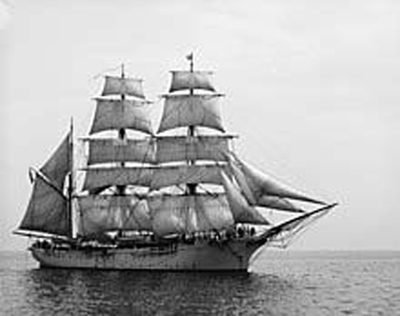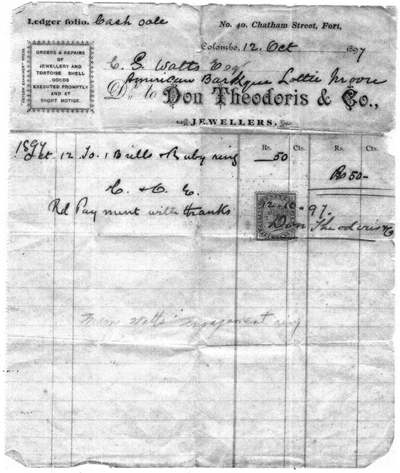‘Lottie Moore’ and the ruby ring
“Sailors then were sailors and ships, ay, they were ships,
When the ports were filled with loveliness and sails were on the sea.”
“Hi, Somasiri,
Now that you have finished with the young Aussie……..”

A three-masted Barque with a sailing rig similar to that of “Lottie Moore”
It was a mail from a fellow member of our maritime heritage chat room. I had just completed a most rewarding search for a young Australian boy whose ship had called at Colombo while he was going to fight in the First World War.
“…….can you help me with a query about my grandfather who had also touched at Colombo in the days of sail?”
Just up my street. My grandfather too had “run away to sea” as a schoolboy and sailed the seven seas before coming home to get married.
“Details! Details! I want details!” I replied.
“Well, he was a sailor, and master of his ship, the “Lottie Moore”. He used to sail between the US and Australia/New Zealand in the late nineteenth century…..”
I needed to check out this ship. She was, I gathered a type of ship called a “Barque”: “a sailing ship, typically with three masts, in which the foremast and mainmast are square-rigged and the mizzenmast is rigged fore-and-aft”.
It was a common type of cargo ship in the days of sail, of respectable size: 880 tons.
“Lottie Moore” was an American vessel. What was she doing in Colombo? I searched for her on the internet and gathered various references to her: very brief and lacking in detail. They were from shipping notices in such journals as “The New Zealand Herald”, “Sydney Morning Herald” and the “Aukland Star” from the late 1870s to the 1890s. From these scant references she seems to have been sailing south from New York, down the Atlantic coast, through the Straits of Magellan at the southern end of South America. From there she may have used the prevailing winds to sail across the Pacific Ocean to Wellington and Aukland. On her return voyage she is reported to have called at Newcastle (Australia), Pedang (Sumatra), Hong Kong and thence across the Pacific to Valparaiso (Chile) before rounding Cape Horn for home. She must have carried cargo to and from every port at which she called: there is one reference to her loading “2,680 (c)ases 534 bags of gum, 166 bales flax” on her return journey.
Colombo had overtaken Galle as Ceylon’s major port and business was brisk. But Capt. Watts was not interested in all that: his mind went back to the Ceylon of legend and to Sindbad the Sailor and his tales of the Valley of Gems, the “Great Ruby” of Cosmos Indicopleustes, of Marco Polo and Sir John Mandeville. Capt. Watts was not in search of the “Great Ruby” but……he wanted a RUBY.
He had a good reason for wanting one: after the voyage was over he was going to “plight his troth” to his sweetheart who was waiting for him. Sailors are sentimental people, and they need these emotional bonds on their long months away from home. In fact, his very ship had been named after a woman: I stumbled upon a reference in a genealogy website to a Miss Charlotte (‘Lottie’) Moore who married a Capt. Claydon who, I presumed, named the ship after her. So Capt. Watts was in good company.
So he wanted a ruby ring. Like many another sailor he went shopping. Not far from his anchorage was Chatham Street with its many, many shops that could give every sailor what he wanted.

The faded receipt of sale for the ruby ring, dated Oct. 12, 1897
Chatham Street, then, was an unpaved, cabook street shaded by katu imbul trees and flanked by shops. It may have been the first shop he visited, or maybe it was the last. But it was at No.40, Chatham Street that he found the ring he wanted. It was an impressive faceted ruby solitaire ringed with diamonds of brilliant cut (this is how I remember the picture which, alas! I have misplaced). The cost was a princely Rs.50/-.
“…Somasiri, the ring is still in our family – and also the sales invoice! I can send you pictures – can you tell me who the jeweller was ?”
When the images reached me, my wife was more excited than I. It was not the beauty of the ring that excited her, but the picture of the faded receipt of sale. On 12th October, 1897, the ring had been sold to “C.S.Watts Esqr” of the “American Barque Lottie Moore”. The jeweller was “Don Theodoris & Co.” of 40, Chatham Street, Fort. The city is not shown: which is why my friend had asked me to help.
Don Theodoris Weerasiri was none other than my wife’s own great-grandfather, who had founded the business in Galle – then the major port – and later branched out to Colombo when that port reached pre-eminence, “…until at this day Messrs. Don Theodoris & Co. rank among the very first of local jewellers…” as is recorded in “Twentieth Century Impressions of Ceylon”.
Don Theodoris’ name was known beyond Ceylon’s shore. He had exhibited at a Fair in Milan, Italy, and been so impressed with the city that he named his infant daughter (my wife’s grandmother) “Turin”. He had exhibited more successfully in later international fairs, as he proudly claimed in notices such as the one where he refers to his royal patrons. “Twentieth Century Impressions” describes this claim: “In 1901 the Prince of Wales and Prince Waldemar of Denmark, when visiting Ceylon, made large purchases of the firm, who received signed photographs from the royal visitors.”
The Royal Patrons would have made “large purchases” but, alas! we know not what happened to them. But we do know that one ruby ring, bought with love for a beloved, is still preserved in America, treated with love and a family heirloom. What more can one ask for?
The firm fell on bad days a decade or so later and went into liquidation. The stock-in-trade was divided among the partners. The premises cannot even be identified now. The goodwill, though, was passed down to a nephew and, in Queen’s Hotel, Kandy, you will yet see the name of “Don Theodoris & Co.” beckoning to the discerning buyer.


